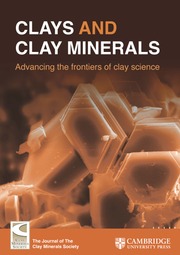Article contents
Diffusion of Water in Li-Montmorillonite Studied by Quasielastic Neutron Scattering
Published online by Cambridge University Press: 01 July 2024
Abstract
The diffusion of water in Li-montmorillonite was studied by incoherent quasielastic neutron scattering. Experiments were carried out on sedimented samples equilibrated at relative humidities of 32%, 58%, and 98%, corresponding approximately to 1, 2, and 3 molecular layers of water in the clay. At all three humidities, although the mobility of the water molecules is less than in bulk water, all water molecules in the system undergo translational diffusion, at least over short distances (>5 Å), with correlation times shorter than 5 × 10−11 sec.
Various models of molecular motion have been used to account for the exact shape of the scattering. The only completely successful model is one where a water molecule undergoes jump-translational diffusion and rotational diffusion. The mean square jump length is 10–15 Å2 with a residence time between jumps of 4–2 × 10−11 sec. The translational diffusion coefficient increases with humidity, having values of 4, 7, and 10 × 10−10 m2/sec for the three humidities. These values can be combined with values previously obtained by tracer measurements to give an estimate of 0.75–0.8 for the tortuosity factor. Although the samples are anisotropic, there is no clear evidence that the diffusion of water over distances 5–20 Å is anisotropic. An upper limit of 3 can be deduced for the rate of diffusion parallel to the direction perpendicular to the platelets.
Резюме
Изучалась диффузия воды в Li-монтмориллоните при помощи некогерентного рассеяния квазиупругих нейтронов. Эксперименты были проведены на осажденных образцах, уравновешенных при относительных влажностях 32%, 58%, и 98%, соответствующих приблизительно 1, 2, и 3 молекулярным слоям воды в глине. При всех трёх влажностях все модекулы воды в системе подвергаются поступательной диффузии, по крайней мере, на коротких расстояниях (>5 Å), со временами корреляции короче, чем 5 × 10−11 сек, хотя мобидьность водных молекул меньше, чем в основном количестве воды. Различные модели молекулярного движения были использованы для определения точной формы рассеяния. Единственно полностью успешной моделью является модель, в которой молекулы воды подвергаются скачкообразной поступательной диффузии и ротационной диффузии. Средняя квадратичная длина скачка равна 10–15 Å2, при времени пребывания между скачкоми равным 4-2 × 10−11 сек. Коэффициент поступательной диффузии увеличивается со влажностью, принимая величины 4, 7, и 10 × 10−10 м2/сек для трёх вышеуказанных влажностей. Эти величины вместе с предварительно полученными данными при помощи измерений методом меченых атомов дают для фактора кривизны величины 0,75-0,8. Хотя образцы были анизотропны, нет очевидного доказательства, что диффузия воды на расстояниях 5–20 Å является анизотропной. Для скорости диффузии параллельной направлению перпендикулярному к тромбоцитом, может быть выведен верхний предел равным 3. [Е.С.]
Resümee
Die Diffusion von Wasser in Li-Montmorillonit wurde mit Hilfe inkoherenter quasielastischer Neutronenstreuung untersucht. Die Experimente wurden mit Sedimentproben durchgeführt, die bei einer relativen Feuchtigkeit von 32%, 58%, und 98% ins Gleichgewicht gebracht wurden, was etwa 1, 2, und 3 Moleküllagen Wasser im Ton entspricht. Bei allen drei Feuchtigkeitsgraden unterliegen alle Wassermolekfile im System einer translatorischen Diffusion, zumindest über kurze Entfernungen (>5 Å) mit Korrelationszeiten von kleiner als 5 × 10−11 sec, obwohl die Beweglichkeit der Wassermoleküle kleiner ist als im Wasser an sich.
Verschiedene Modelle für die Molekfilbewegung wurden zur exakten Deutung des Streuverhaltens herangezogen, Das einzig wirklich anwendbare Modell ist das, in dem ein Wassermolekül einer sprunghaften translatorischen Diffusion oder rotatorischen Diffusion unterliegt. Die mittlere quadrafische Sprunglänge beträgt 10–15 Å2 mit einer Verweilzeit zwischen den Sprüngen von 4–2 × 10−11 sec. Der translatorische Diffusionskoeffizient, der mit dem Feuchtigkeitsgrad zunimmt, zeigt Werte von 4, 7, und 10 × 10−10 m2/sec für die drei Feuchtigkeitsgrade. Diese Werte können mit Werten verglichen werden, die kürzlich bei Tracermessungen erhalten wurden, und eine Schätzung von 0,75–0,8 für den Torsionsfaktor ergeben. Obwohl die Proben anisotrop sind, gibt es keinen eindeutigen Hinweis, daß die Diffusion von Wasser über eine Entfernung von 5–20 Å ebenfalls anisotrop ist. Für die Diffusionsgeschwindigkeit parallel zur Richtung senkrecht auf den Plättchen kann auf eine obere Grenze von 3 geschlossen werden. [U.W.]
Résumé
La diffusion d'eau dans la montmorillonite-Li a été étudiée par éparpillement incohérent quasiélastique de neutrons. Des expériences ont été faites sur des échantillons sédimentés équilibrés à des humidités relatives de 32%, 58%, et 98%, correspondant approximativement à 1, 2, et 3 couches moléculaires d'eau dans l'argile. Pour les trois humidités, quoique la mobilité des molécules d'ean est moins que dans l'eau en masse, toutes les molécules d'eau dans le système subissent une diffusion translationelle, au moins sur de courtes distances (>5 Å), avec des temps de correlation plus courts que 5 × 10−11 sec.
Des modèles variés ont été utilisés pour rendre compte de la forme exacte de l’éparpillement. Le seul modèle connaissant un succès complet est celui où une molécule d'eau subit une diffusion translationellesaut et une diffusion rotationelle. La distance de saut moyenne quarrée est 10–15 Å2, avec un temps de résidence entre les sauts de 4–2 × 10−11 sec. Le coéfficient de diffusion translationelle croît proportionellement à l'humidité, ayant les valeurs de 4, 7, et 10 × 10−10mg2/sec. Ces valeurs peuventêtre combinées à des valeurs obtenues précédemment par des mesures de traceur, pour donner une estimation de 0,75–0,8 pour le facteur de tortuosité. Bien que les échantillons sont anisotropiques, il n'y a pas d’évidence claire que la diffusion d'eau sur des distances de 5–20 Å est anisotropique. Une limite supérieure de 3 peut être déduite pour le taux de diffusion parallèle à la direction perpendiculaire aux plaquettes. [D.J.]
Information
- Type
- Research Article
- Information
- Copyright
- Copyright © 1981, The Clay Minerals Society
References
- 89
- Cited by

